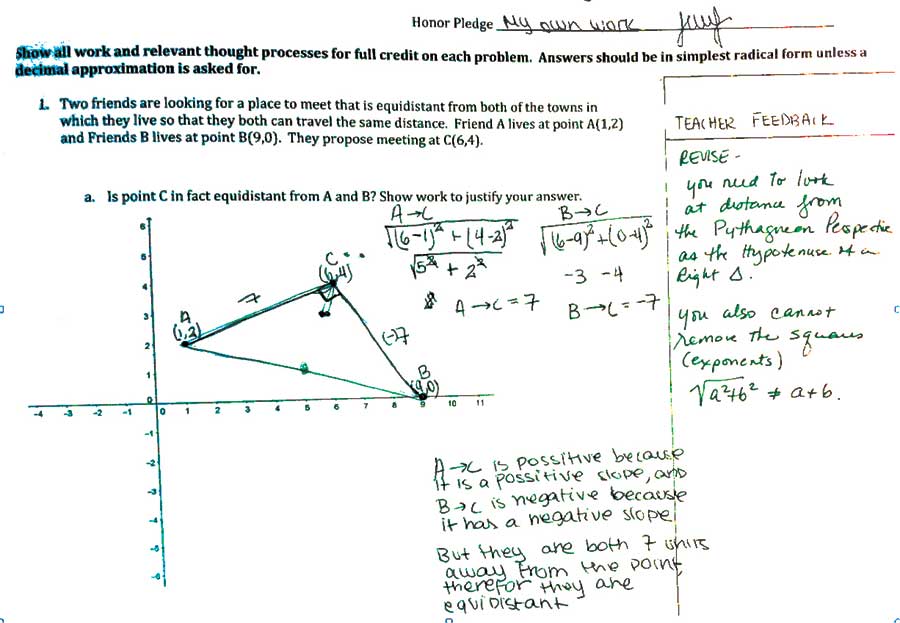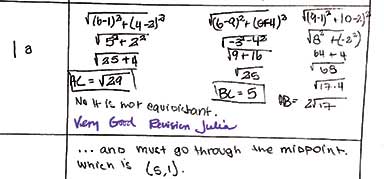By
Carmel Schettino, posted October 24, 2016 —
There are many different names for
assessments—test, quiz, chapter test, quest, SLO (Student Learning
Opportunity), Portfolio of Work, Knowledge Showcase—all of which mean the same
thing to most students. When I started teaching with PBL, I found it difficult
to align assessment practices with the learning goals of a PBL classroom (see my
previous post). When students would do great work in
class on their problem-solving or communication skills, I wanted to give them the
feedback they deserved, to improve and to be supported in that work. Instead,
without giving them that feedback, I felt like I was losing my integrity as a
teacher.
To let my students know that major
assessments are going to address both the use of content skills and the
techniques of good problem solving, I call them problem sets. I tell students
that they should expect some problems that they have seen before as well as
others that have connections to what we have done. I’ll expect them to make
those connections for themselves in class instead of at home.
I provide a study guide that gives an
outline, by topic and page number, of the topics we have recently covered. Our
problem-based curriculum is not compartmentalized, so students and I work
together on a daily basis, categorizing the topics we are covering. Students
also do metacognitive journaling on problems that stood out to them (i.e., they
write about what was helpful in their learning and how it helped).
I
grade problem sets with “Feedback before Grades with Revisions” (thanks to
helpful people on #MTBoS for ideas and advice on this). I give a score for both
initial conceptual understanding and initial skill ability, but students do not
see their final grade until after completing the revisions. For example, my student Julia needed to find
out if point C was equidistant from A and B, but she was confused about what
that meant. Conceptually, Julia was thinking of slope instead of length, and
skill-wise, she was manipulating the distance formula incorrectly. My feedback
for her revisions was intended to make her aware of both of those errors.

The
next day, I was quite impressed with how, after reading my feedback, Julia was
able to completely correct her work! The assessment was truly a learning
experience as problem solving.

The
rubric that I use to grade problems sets this year with “Feedback before Grades
with Revisions” is on my website. This type of assessment
didn’t change the overall average of four sections of geometry last year, but it
allowed students to focus on their learning and not (as much) on their grades.
I have remained true to the pedagogy and learning goals that are so important
to me as a teacher and that I want students to gain from their experience in my
classroom.
 With problem-based learning as her
specialization, Carmel Schettino obtained a PhD in math education
while teaching at the secondary level for more than twenty years. She is
passionate about helping teachers grapple with the pedagogical and curricular
questions that arise when PBL is brought into the math classroom. Her other
areas of expertise include gender equity, discourse, technological implications
and PBL's relationship to the Common Core. Schettino has consulted for a number of schools,
has presented for NCTM (e.g., Annual Conferences 2015 and 2016) and has published articles with respect to PBL in the secondary
mathematics classroom. Find her blog at carmelschettino.org, and contact her
at [email protected].
With problem-based learning as her
specialization, Carmel Schettino obtained a PhD in math education
while teaching at the secondary level for more than twenty years. She is
passionate about helping teachers grapple with the pedagogical and curricular
questions that arise when PBL is brought into the math classroom. Her other
areas of expertise include gender equity, discourse, technological implications
and PBL's relationship to the Common Core. Schettino has consulted for a number of schools,
has presented for NCTM (e.g., Annual Conferences 2015 and 2016) and has published articles with respect to PBL in the secondary
mathematics classroom. Find her blog at carmelschettino.org, and contact her
at [email protected].